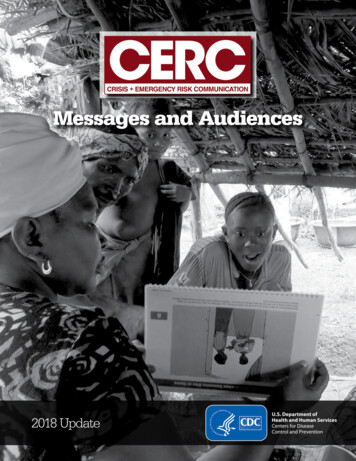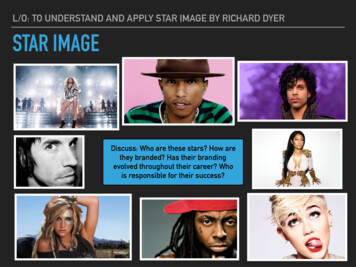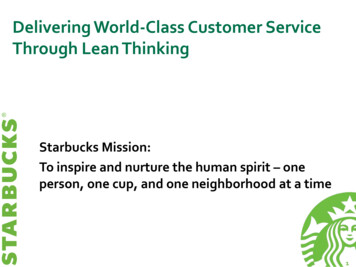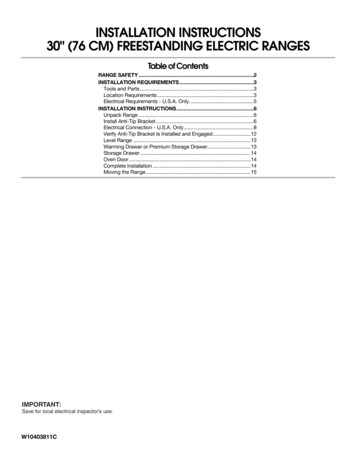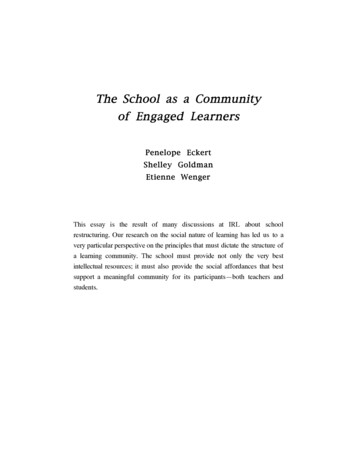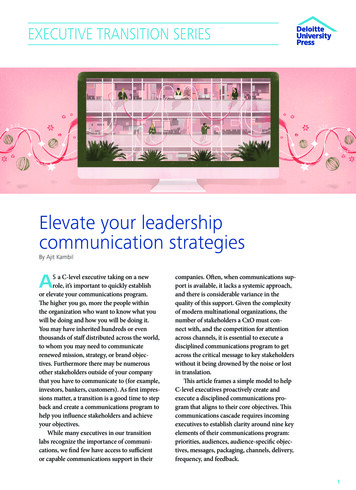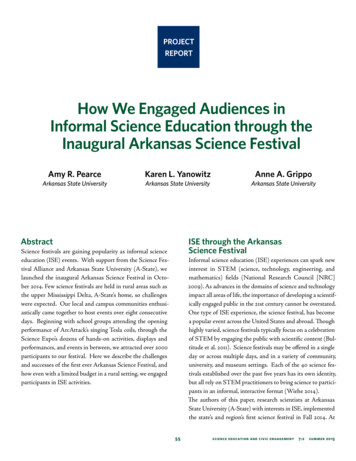
Transcription
PROJECTREPORTHow We Engaged Audiences inInformal Science Education through theInaugural Arkansas Science FestivalAmy R. PearceArkansas State UniversityKaren L. YanowitzArkansas State UniversityAbstractAnne A. GrippoArkansas State UniversityISE through the ArkansasScience FestivalScience festivals are gaining popularity as informal scienceeducation (ISE) events. With support from the Science Festival Alliance and Arkansas State University (A-State), welaunched the inaugural Arkansas Science Festival in October 2014. Few science festivals are held in rural areas such asthe upper Mississippi Delta, A-State’s home, so challengeswere expected. Our local and campus communities enthusiastically came together to host events over eight consecutivedays. Beginning with school groups attending the openingperformance of ArcAttack’s singing Tesla coils, through theScience Expo’s dozens of hands-on activities, displays andperformances, and events in between, we attracted over 2000participants to our festival. Here we describe the challengesand successes of the first ever Arkansas Science Festival, andhow even with a limited budget in a rural setting, we engagedparticipants in ISE activities.Informal science education (ISE) experiences can spark newinterest in STEM (science, technology, engineering, andmathematics) fields (National Research Council [NRC]2009). As advances in the domains of science and technologyimpact all areas of life, the importance of developing a scientifically engaged public in the 21st century cannot be overstated.One type of ISE experience, the science festival, has becomea popular event across the United States and abroad. Thoughhighly varied, science festivals typically focus on a celebrationof STEM by engaging the public with scientific content (Bultitude et al. 2011). Science festivals may be offered in a singleday or across multiple days, and in a variety of community,university, and museum settings. Each of the 40 science festivals established over the past five years has its own identity,but all rely on STEM practitioners to bring science to participants in an informal, interactive format (Wiehe 2014).The authors of this paper, research scientists at ArkansasState University (A-State) with interests in ISE, implementedthe state’s and region’s first science festival in Fall 2014. At55 science education and civic engagement7:2summer 2015
set a date for our festival in collaboration with the performing arts center on our campus and secured a science-themedmusical group, ArcAttack, folding their performances into anestablished family-friendly concert series. Our other activities were planned to span the weekend of that date, and wewould use the ArcAttack performances on the first Friday ofOctober 2014 to attract area students and their families backto campus for the Science Expo the following day.IssuesOur first setback occurred shortly after finalizing the datefor ArcAttack: we could not schedule campus activities thefollowing day, as homecoming, a major athletic event for ouruniversity, was now planned for that date. Making “lemonadefrom lemons,” we decided to participate in homecoming bysecuring a tailgate tent to host activities and promote otherscience festival events, which would now span eight consecutive days, culminating in the Science Expo the following Saturday. Another issue was that we needed to secure universityapproval for a logo design and promotional materials throughour Office of Marketing and Communications, which wefound to be a very busy office. Additionally, there were difficulties in clearing university protocol when soliciting community members for their financial support and inviting outsideentities to join in the celebration. This “red tape” caused us tolag behind in both promotion and fundraising for our festival.FIGURE 1. A rkSciFest attendees in the Faraday Cage atArcAttackthe time of planning, approximately 50 science festivals werelisted on the Science Festival Alliance website, yet none waslisted in the rural South. Scientific literacy is important forall; however, inhabitants of rural communities seldom haveopportunities to engage in ISE activities. Our targeted regionwas the upper Mississippi Delta, which has some of the lowestpopulation densities in the southern U.S. This economicallypoor region has a historically agricultural focus, little STEMindustry, and some of the lowest levels of higher education inthe country. The 2014 state data tool of the National ScienceBoard revealed that only 13.8 percent of Arkansans hold bachelor’s degrees, while fewer than 9.2 percent of the residents ofthe Delta region of Arkansas have a bachelor’s degree (NSB2014), one of the lowest rankings in the country. Comparableresults are found in other states in our recruitment region.Our immediate region, the Jonesboro, Arkansas area, with almost 72,000 people, has a fairly diverse population, approximately 71 percent Caucasian, 18 percent Black, and 6 percentHispanic (Cubit Planning 2015). Median household incomein 2013 was approximately 39,000, with more than 25 percentof city residents living in poverty (Cubit Planning 2015).To build the first Arkansas Science Festival, we soughtfunding through an initiative from the Alfred P. Sloan Foundation managed through the Science Festival Alliance, agroup whose mission is to help create more and better science festivals. On our campus, the Colleges of Education andBehavioral Science, Sciences and Mathematics, and the Arkansas Biosciences Institute provided internal matching funds.Through these generous entities, we had an initial total budgetof 20K. Using a preliminary A-State activity schedule, wePearce, et al.: Inaugural Arkansas Science FestivalBack on TrackWith our first two events secured, we sought collaboratorswithin our community and across the state. The county publiclibrary offered to sponsor an activity during festival week, andalso agreed to participate in the Science Expo. The organizerof a long-running science café in Little Rock (140 miles away)assisted us in hosting the first science café in our region forthe festival. We secured an award-winning Arkansas authorand radiologic technologist to present a talk on Marie Curieat the Expo, as well as community music groups to present atour homecoming tent. The Arkansas Museum of Discovery(also from Little Rock) arranged to bring their mobile sciencemuseum to be enjoyed by student groups on opening day.56 science education and civic engagement7:2summer 2015
Campus CollaborationsWe found many enthusiastic campus collaborators and colleagues. The Arkansas State University Museum planned“warm up” activities for visiting regional students prior to themorning ArcAttack performance, as did staff from the Ruraland Delta STEM Education Centers on campus. A professor of theatre suggested “Playing with Science,” a nationalplaywriting contest for short science plays. A rock band comprised of faculty and students agreed to perform at the Expo,and several individual faculty, graduate students, and studentgroups began organizing activities to be presented at the Expoand in the homecoming tailgate tent. Many of the student organizations affiliated with the College of Sciences and Mathematics received guidance from the Student Club Coordinator,who is also currently working on a project of civic engagementsponsored through a SENCER SSI Implementation grant.One of the authors (KY) organized a research methodologycourse in which undergraduate students designed field studiesto be conducted at the various activities. Further, a strategiccommunications team adopted the science festival as a classproject; these undergraduate students organized and plannedpromotional strategies, and one interned part-time during thesummer to help launch our website, Facebook page, and otherpromotions. Local media, including our campus NPR station,local television station, and newspaper, announced activities,and ran interviews, ads, and articles.FIGURE 2. A rkSciFest attendees launch a weather balloon tobagpipes.FIGURE 3. Checking out the ELF, a solar-powered tricycle.Festival WeekThe “Singing Tesla Coils” of ArcAttack kicked off the festivalwith a daytime school-based show, followed by an eveningshow for the public. Together, the two programs brought inover 1,100 children and adults. The next day’s HomecomingScience Tailgate Tent presented the launch of weather balloons to the sound of bagpipes, solar-cooked hotdogs, beergoggle Baggo, juggling, marine touch tanks, and an entomology collection. This event involved more than 250 attendeesand volunteers and reached a large cross section of the community, and we had a welcome visit by a mentor from theScience Festival Alliance. Other events included the astronomy-themed science café held at a local restaurant, a tinkering studio in the A-State museum, a unique mindfulness andbiofeedback workshop, and a science of music event at thecounty public library. Another standout program was “Playingwith Science”; over seventy-five original short science playsPearce, et al.: Inaugural Arkansas Science Festivalhad been submitted by local, national, and international playwrights (some of them award winners). This fusion of scienceand the arts was brought to life through readings of the finalists in the playwriting contest by both scientists and actors.The festival closed with the Science Expo which featured overtwenty-five activity stations and events and attracted approximately five hundred participants. The total cost of the eightday festival was under 10,000, which was used for promotion,supplies, and the paid performances of ArcAttack. All laborwas done by volunteers, including faculty, staff, and studentsfrom A-State, as well as community members and museumstaff. We estimate that approximately 125 volunteers spent atotal of 500 hours in planning and carrying out all the eventsheld over the eight days of the Festival.57 science education and civic engagement7:2summer 2015
was measured simply by the number of people entering thehall and was not broken down by age, it is impossible to tellwhat percentage of the adult attendees completed the survey,a limitation of this research. However, 62 percent of the adultswho completed surveys indicated they had brought childrenwith them; thus, we theorize that we have captured a higherproportion than 14 percent of the adult population who attended the Expo.Items were designed to assess perceptions of differentaspects of the event, and three different forms were utilized.All participants were first asked why they attended the event.Then all participants were asked to rate the event on a fivepoint scale (5 excellent, 1 poor). A series of statementswere then given to all participants to assess impact on interest/learning, such as “Now I’m more interested in STEM than Iwas before coming today,” affective reactions such as “I enjoyedmyself at this event—it was fun,” and impact on engagement,such as “I totally got into what I was seeing or doing at theevent; I was really engaged in what I was doing.” Participantsresponded to these using a Likert-type scale (5 stronglyagree). The remaining items varied depending on which formparticipants received. This paper focuses on the items that allparticipants received.Participants had a wide variety of reasons for attendingthe Expo. The most common response (40 percent) focusedon attending because of children or grandchildren. Meansfor all items were significantly higher than the neutral point,p .001. Twenty percent mentioned they enjoyed science orwere interested in learning more about science or the exhibits,and 11 percent believed the event would be fun. (Note: participants’ responses could fall into more than one category.)Results revealed that participants rated the result quite highly,M 4.4, SD 0.6. A one-sample t-test revealed this wassignificantly higher than the midpoint of the scale (which waslabeled as “good”), t(68) 19.5, p .001. Finally, participants’responses to individual survey items (see Table 1) also revealthat participants reported positive effects in learning STEMcontent, were engaged in the activities, and had positive affective responses. Again, a one-sample t-test revealed all meanssignificantly higher than the neutral midpoint of the scale, p .001. Perhaps most tellingly, the most highly rated item wasagreement that attendees would be interested in attendinganother science festival. No significant correlation was foundbetween age and any of the items, and no differences werefound as a function of gender.FIGURE 4. A rkSciFest Playing with Science Short PlayExperiment.Several Goals Attained!With the financial support of the Alfred P. Sloan Foundation,mentorship from the Science Festival Alliance, and the support of the many volunteers, Expo hosts, event hosts, studentand community organizations, speakers, and performers, wereached our goal of bringing science, technology, engineering, math, and health professions to over 2,000 people in ourcommunity (from Jonesboro’s population of about 72,000) inexciting and educational formats. Due largely to our volunteers’ generous assistance, we spent less than half of our initialbudget, enabling us to maintain some funding toward the 2015Arkansas Science Festival.Attendees were asked to provide feedback regarding theirexperiences by completing a brief survey given by student volunteers (Table 1) who were stationed outside the exit doorsof the Expo. Sixty-nine adult attendees completed the survey(66 percent female; M age 37 years, range 18 to 67 years;83 percent Caucasian, 3 percent African-American, 3 percentAsian, 2 percent Hispanic; 8 percent selected “other” or multiple categories). We estimate this was approximately 14 percentof all attendees, both children and adults. Since attendancePearce, et al.: Inaugural Arkansas Science Festival58 science education and civic engagement7:2summer 2015
committed to being a part of the second Arkansas Sciencefestival, expanding the festival beyond the Northeast Arkansas region.Table 1. A dults’ Ratings of the ArkSciFest’s Science Expo(Mean and Standard Deviation)ItemM (SD)I would like to attend another science festival.4.7 (0.5)I enjoyed myself at this event—it was fun.4.6 (0.5)I enjoyed the booths and displays at the science festival.4.5 (0.6)ReferencesArkansas Science Festival. 2014. http://www.astate.edu/asf/ and https://www.facebook.com/arkansassciencefestival (accessed May 14, 2015).Bultitude, K., D. McDonald, and S. Custead. 2011. The Rise and Rise ofScience Festivals—An International Review of Organized Events toCelebrate Science. International Journal of Science Education, Part B,1 (2): 165–188.Cubit Planning. 2015. ographics (accessed May 14, 2015).Hussar, K., S. Schwartz, E. Boiselle, and G. Noam. 2008. Toward aSystematic Evidence Base for Science in Out-of-school Time: TheRole of Assessment. A Study Prepared for the Noyce Foundation.Program in Education, Afterschool & Resiliency, Harvard Universityand McLean Hospital, Cambridge, MA.Manning, C., K. Lin, M. King, and I. Goodman. 2013. The ScienceFestival Alliance: Creating a Sustainable National Network of Science Festivals. Final Summative Evaluation Report. Cambridge, MA:Goodman Research Group, Inc.National Science Board (NSB). 2014. ate-data (accessed May 24, 2015).National Research Council; Committee on Learning Science in Informal Environments, P. Bell, B. Lewenstein, A.W. Shouse, and M.A.Feder, eds. 2009. Learning Science in Informal Environments:People, Places, and Pursuits. Board on Science Education, Center forEducation. Division of Behavioral and Social Sciences and Education.Washington, DC: The National Academies Press.Science Festival Alliance, 2015. http://sciencefestivals.org/ (accessed May14, 2015).Wiehe. B. 2014. When Science Makes Us Who We Are: Known andSpeculative Impacts of Science Festivals. Journal of Science Communication 13 (4): CO2.Note: all p .001, compared to the neutral point of the scaleDiscussion of ResultsOverall, research and evaluation in ISE has lagged behindprogram development (Bultitude et al. 2011; Hussar et al.2008). Manning, Lin, King, and Goodman (2013) releasedone of the first assessments on science festivals. Manningsurveyed participants at several major science festivals (allheld in urban areas, such as San Diego, San Francisco, andPhiladelphia), and results revealed that 78 percent reportedthat science learning was more fun and enjoyable as a result ofattending the events and that 79 percent claimed they would“look for information on something they had learned at thefestival.” From our Expo, 66 participants who had attended ascience event the prior year reported actually having engagedin behavior to search for more information on a topic, an indication of increased engagement in science. The results fromthe present study augment the limited research by providingevidence that a more rural population may also derive benefitsfrom these types of informal science activities.About the AuthorsNext StepsAmy R. Pearce has a PhD in Neurosciencefrom the Australian National University; sheis a Professor of Psychology at Arkansas StateUniversity and Director of the Arkansas Science Festival. Her interests in science communication, informal science education, and the mentoring ofundergraduate students are reflected in her various professional contributions.New partnerships were formed between festival organizersand the county library, local museum, and university performance hall, all of which have committed to continue in futureyears of the festival. Finalists of “Playing with Science” havebeen selected for publication in an anthology to be disseminated to other festivals and schools. Plans are currently underway for the next Arkansas Science Festival to be hostedin October 2015, and we have partnered with the NSF-sponsored EvalFest team to evaluate it. To continue the growth ofthe festival we intend to form a steering committee as well asan advisory board, and we welcome the Museum of Discovery, Little Rock, and EcoFest, Conway, Arkansas, which havePearce, et al.: Inaugural Arkansas Science FestivalKaren L. Yanowitz has a Ph.D. in Developmental Psychology from the University ofMassachusetts/Amherst and is a Professor ofPsychology at Arkansas State University. She59 science education and civic engagement7:2summer 2015
conducts basic research on cognitive development processes,and its application towards improving science learning. Shehas collaborated with STEM faculty in developing and evaluating science/math improvement programs designed forteachers and for students.Anne Grippo holds a PhD in Medicinal Chemistry from the University of North Carolina atChapel Hill. She is a Professor of BiologicalSciences, and in her additional role as Associate Dean of Undergraduate Programs in theCollege of Sciences & Mathematics at Arkansas State University, she collaborates on many projects to strengthen STEMeducation from elementary through graduate levels.Pearce, et al.: Inaugural Arkansas Science Festival60 science education and civic engagement7:2summer 2015
The authors of this paper, research scientists at Arkansas State University (A-State) with interests in ISE, implemented the state’s and region’s first science festival in Fall 2014. At pROJecT RepORT How we engaged Audiences in informal science education through the inaugural Arkansas science Festival
